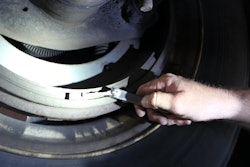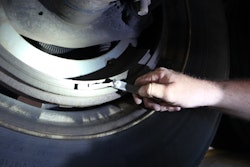By John Smith
 As tough as it appears to be, heavy equipment doesn’t like the cold. When the temperature begins to drop, lubricants can be transformed into thick sludge. Moisture in the brake system can turn to ice. And metal parts of every sort will be exposed to layer upon corrosive layer of chemicals that are used to clear ice from North American highways.
As tough as it appears to be, heavy equipment doesn’t like the cold. When the temperature begins to drop, lubricants can be transformed into thick sludge. Moisture in the brake system can turn to ice. And metal parts of every sort will be exposed to layer upon corrosive layer of chemicals that are used to clear ice from North American highways.
Providing customers with comprehensive preventive maintenance geared toward cold-weather operation is essential to protect them and their equipment against this onslaught.
At a glance, service technicians should be looking for early signs of corrosion (something that will only get worse as the winter progresses) or the weakened tie wraps that could break once air lines and wiring harnesses are coated in a heavy accumulation of snow. Batteries should be tested to ensure they will have the cold cranking amps that are required to start an engine in colder climates.
A switch to synthetic fluids, meanwhile, could help ensure a proper level of lubrication as temperatures begin to plummet. In the transmissions and differentials alone, a synthetic 75W-90 fluid will offer protection in temperatures as cold as -40° F, compared to a conventional 80W-90 that will work down to -15° F.
CHOOSING OILS AND COOLANTS
“For winter service, an important indicator of oil suitability is SAE viscosity grade,” says Erin Olsen, a member of the engine oils team at Chevron Global Lubricants. “The number in front of the W is a measure of pumping and cranking performance.”
He explains that each step lower – for instance, from 10W to 5W – represents a 9° F improvement in low-temperature capability. So, customers in southern states may be able to use a 15W-40 formula throughout the year, but those in colder climes may require a 10W-30 or 5W-40 formula during winter months.
“Generally, a SAE 15W-40 will have good pumpability down to -13° F, while an SAE 5W-40 would extend the range down towards -31° F,” he adds.
In addition to combating friction, any fresh applications of grease also will help develop a protective barrier against de-icing materials.
Of course, these are hardly the only fluids that need to be addressed. A truck’s cooling system, for example, will face additional stress during colder seasons, so a seal and pressure check will be an important addition to any seasonal maintenance package.
“The best and easiest thing for maintenance personnel to do when testing coolant for the onset of cold winter weather is to check the coolant’s freeze point using a refractometer. A 50/50 coolant has a freeze point of -34° F,” says Carmen Ulabarro, direct marketing manager, Chevron Global Lubricants. “If the expected ambient temperature is going to be below -34° F then you can adjust the freeze point by adding more antifreeze/coolant concentrate. [But] the maximum recommended amount of glycol should not exceed 60 percent since adding too much antifreeze concentrate actually can reduce freeze protection.”
In cases where non-extended-life coolants are being used, the inhibitors should also be checked. Conventional coolants that have been run for more than 250,000 miles might even need to be changed to eliminate the solids that can cause plugging.
“If you are using extended-life coolant/antifreeze and have any concerns about how the coolant has been maintained, running a yearly inhibitor test using an approved test kit is not a bad idea,” Ulabarro adds.
And at temperatures below -60° F, a propylene glycol coolant probably will need to be used in the place of a traditional ethylene glycol mixture because of the related freeze points.
MOISTURE IN THE AIR
Maintenance teams also need to pay attention to another sort of liquid that should be avoided at all costs.
Moisture in an air system can be troublesome at the best of times, and it certainly will lead to frozen brakes once the colder weather sets in. This means the air dryer deserves added focus during seasonal maintenance efforts.
Chuck Eberling, a principal engineer with Bendix Commercial Vehicle Systems, refers to the need to check the condition of desiccant cartridges, the air dryer’s heater and the thermostat.
“The heater prevents the purge valve from being frozen in operation,” he notes.
It also will be important to ensure that the air dryer has been sized to meet the needs of the related application. Equipment that was originally spec’d to pull a tandem trailer may not be able to handle the volumes required for a Michigan combination.
Even the installation procedures for an individual valve might need to be updated.
“The valves themselves should not be in a high road-splash situation where they will cause components to be iced over by the road slush,” he explains. If a customer is facing a recurring problem with the frozen components, that may require a call to an OEM to identify another approved mounting site.
Those who work in extremely cold climates also may want to upgrade their valves. Some designs can maintain their seal integrity down to a frigid -50° F, compared to the normal limits of -40° F, Eberling adds.
Meanwhile, any replaced discharge lines should slope downward from the compressor’s discharge port to ensure that water is not allowed to pool in place. Any crossovers from one side of the frame rail to the next should occur as close as possible to the compressor, and fitting extensions should be avoided at all costs.
Technicians should be wary about some misplaced cold-weather maintenance techniques as well. The use of a torch to melt a frozen valve could melt the seals that are found inside. It could even lead to a fire – especially if a customer has attempted to thaw a valve by pouring alcohol into the gladhands, Eberling says.
Frozen valves should always be gradually thawed inside a service bay.
ATTACKING THE HVAC
The performance of heaters and auxiliary power units will be vital to ensure driver comfort during winter months.
Many of the inspections surrounding HVAC systems will involve something as simple as a human touch. Service technicians shouldn’t be able to feel any air leaks from a running defroster when they run their hands under the dash. And any holes in the duct work should be patched with a compound or high-quality duct tape that is designed specifically for a heating system.
The quality of the air is equally important. The HVAC system will have at least one filter to capture dust, lint or other impurities that can clog heat exchangers, explains Gary Hansen, vice president of Red Dot, which designs and manufactures heating and air conditioning systems. Some vehicles will include a filter on the inlet for fresh air as well as re-circulated air (the filter for the heating system in the sleeper typically will be for re-circulated air, and will be accessed through the toolbox or under the bunk). Off-road equipment may be equipped with an exterior filter to trap additional impurities.
In each case, the filters should be checked every three months, and replaced as necessary.
From a mechanical standpoint, blower motors also should be inspected to determine if they need to be replaced.
“On a cold morning, the motor goes from zero to full-speed in one swift turn of the knob,” Hansen says. “The motor should take no more than 30 minutes to remove and replace, so do it at the first sign of trouble.”
The heater’s water valves also should open and close completely without stretching the actuator cables. “If the driver tries to force the valve to open or close, he risks stretching the cable and damaging the valve,” Hansen adds. Technicians who discover these tight controls should inspect the valve at the actuation point, being careful not to force the valve open themselves.
“Some of the valves have an O-ring in them and we find that sometimes they dry out and they can tear when you force them,” he says. That will lead to complaints from drivers who can’t seem to shut off their heaters.
The receiver-dryer should be replaced once a year, he adds. Otherwise, the desiccant can be saturated, allowing moisture to combine with the refrigerant to create a corrosive hydrofluoric acid. A blue dot in the sight glass on an available moisture indicator will show that the refrigerant is dry, while pink, white or grey will indicate trouble.
BELTS AND HOSES
Bunk heaters also should be checked to ensure tight electrical connectors, snug belts and flexible hoses.
Any weak hoses – regardless of where they are found – could be more prone to ruptures when they are exposed to extreme swings in ambient temperatures. Service technicians need to be on the lookout for signs of blisters, cracks and hard and soft spots.
“[Look for] anything that would give us a sign the hose is not pliable anymore,” explains Tim Hottovy, heavy-duty channel manager with Goodyear Engineered Products.
Ideally, the schedules for hose and belt replacements should be based on miles in service. But the choice of clamps also can play a role when looking to offer an additional level of seasonal protection.
“There are different levels of stainless out there,” Hottovy says, referring to the importance of choosing a hex, housing and band that is made of 303-grade stainless steel. “We don’t want an operator stranded on the side of the road.”
Since additional debris and road salt also will be kicked up from a winter road, the condition of any belts and snow shields also is important.
“Is there wear on the belt? Is there wear on the backside of the belt? Is there abnormal wear on the inside of the pulleys?” Hottovy asks. All of these could indicate signs of trouble with a pulley or a tensioner.
But by offering customers a thorough inspection like this, shops will be able to prevent the breakdowns that can occur when the cold winds begin to blow.








